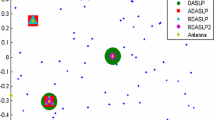Abstract
We consider a cellular CDMA system in which blocking is enforced when the relative interference exceeds a certain threshold level. This paper addresses a radio network design problem in such a CDMA system. Given the data of call‐traffic distributed over the service area and potential sites of base stations, the objective of the problem is to locate base stations so as to minimize the associated cost for establishing base stations while keeping the probability of blocking under control. We develop an efficient algorithm for solving the design problem. Computational experiments with real‐world data are conducted to show both the efficiency and the practicality of the proposed design method.
Similar content being viewed by others
References
H.O. Beća, D.S. Paunović and I.S. Stojanović, A design concept for reconfigurable mobile radio networks with slow frequency-hopping signaling, IEEE Journal on Selected Areas in Communications 8 (1990) 603–612.
G.R. Cooper and R.W. Nettleton, A spread-spectrum technique for high-capacity mobile communications, IEEE Transactions on Vehicular Technology 27 (1978) 264–275.
M.L. Fisher and P. Kedia, Optimal solution of set covering/partitioning problems using dual heuristics, Management Science 36 (1990) 674–688.
A. Gamst, Remarks on radio network planning, in: IEEE VTC (1987) pp. 160–165.
K.S. Gilhousen, I.M. Jacobs, R. Padovani, A.J. Viterbi, L.A. Weaver, Jr. and C.E. Wheatley, On the capacity of a cellular CDMA system, IEEE Transactions on Vehicular Technology 40 (1991) 303–312.
W.C.Y. Lee, Mobile Cellular Telecommunications Systems (McGraw-Hill, New York, 1990).
Z. Liu and M.E. Zarki, SIR-based call admission control for DS-CDMA cellular systems, IEEE Journal on Selected Areas in Communications 12 (1994) 638–644.
I. Nasell, Some properties of power sum of truncated normal random variables, Bell System Technical Journal 46 (1967) 2091–2110.
S.M. Ross, Probability Models (Academic Press, Orlando, 1985).
H.D. Sherali, C.M. Pendyala and T.S. Rappaport, Optimal location of transmitters for micro-cellular radio communication system design, IEEE Journal on Selected Areas in Communications 14 (1996) 662–673.
D. Stamatelos and A. Ephremides, Spectral efficiency and optimal base placement for indoor wireless networks, IEEE Journal on Selected Areas in Communications 14 (1996) 651–661.
A.J. Viterbi, The orthogonal-random waveform dichotomy for digital mobile personal communication, IEEE Personal Communication 1 (1994) 18–24.
A.M. Viterbi and A.J. Viterbi, Erlang capacity of a power controlled CDMA system, IEEE Journal on Selected Areas in Communications 11 (1993) 892–900.
R.W. Wolff, Stochastic Modeling and the Theory of Queues (Prentice-Hall, Englewood Cliffs, NJ, 1989).
Author information
Authors and Affiliations
Rights and permissions
About this article
Cite this article
Tcha, D., Myung, Y. & Kwon, J. Base station location in a cellular CDMA system. Telecommunication Systems 14, 163–173 (2000). https://doi.org/10.1023/A:1019141400826
Issue Date:
DOI: https://doi.org/10.1023/A:1019141400826




